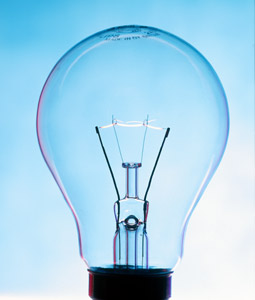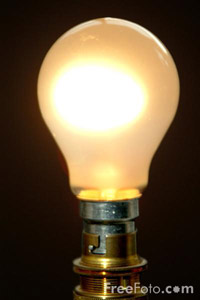
by W.A. Steer PhD


Yes, I'm concerned about the environment, global warming, and about the profligate and
spiralling energy consumption of the developed- and developing world. I'm also irritated by
many of the headline-grabbing campaigns which, though well-meaning, appear to be more about
gaining environmental 'brownie points' than actually making any real difference. Space-heating
and transport use far more energy than lighting, so why the demonisation of the humble
incandescent lightbulb?
Introduction
Matt Prescott is heading a campaign to "Ban the Bulb"
- to get the [British] government to ban the traditional incandescent lightbulb in the name of
energy-efficiency and saving the environment. It's perfectly true that the ordinary lightbulb is
quite inefficient at converting electricity to light (most of the energy goes directly to heat),
but compact fluorescent lamps (CFLs) are not universally superior or even equivalent replacements.
By all means encourage people to try them, but considering the wider picture an outright ban
on the use or sale of traditional bulbs using the force of law would be a draconian measure and
totally disproportionate.
I'm keen on energy saving (it should invariably save you money too), but these kind of
campaigns are simplistic, discourage critical thinking and ignore the elephant in the room
(heating and transport).
- Fluorescent lamps distort colours making a room appear grey, flat, lifeless, and even "clinical".
Wood and skin colours often take on an unhealty greenish tinge, and make food look most unappetising.
-
As a colour-scientist and amateur photographer, my eyes are offended by the colour-characteristics of fluorescent light.
-
As a physicist my intellect is offended by disproportionality of the notion of calling for a ban on a form of
lighting which accounts for less than 1% of the total national CO2 generation while largely ignoring car-use
and the over-heating of homes and business premises where vastly greater savings could be made.
-
I'm quite happy to aim for a low-energy lifestyle, but please, stop the nannying and leave the details
of how I achieve that up to me!
Savings from the use of CFLs are small or comparable to other household activities...
So why pick out the lightbulb?
- In a typical British household, replacing standard bulbs with CFLs would save not much more than
2% of the total household direct CO2 emissions (from electricity+gas+car use)
- Daily, this amount of CO2 is roughly equivalent to that emitted by:
- driving a car 1 or 2 miles
- half a drying programme in a tumble dryer
- refining primary aluminium to manufacture two aluminium drinks cans
- a typical TV/satellite box/DVD player installation being left in standby rather than switched off at wall when not in use
- At typical UK mileage you'd save ten times more CO2 by swapping a gas-guzzling 4x4 for a smaller
family car.
- Many households could probably also save ten times as much CO2, relatively painlessly, by
being more frugal with their heating, reducing the thermostat temperature, and using the timeswitch to
turn off (or manually turn right down) the heating during the hours when the house is unoccupied, or
overnight.
According to Ofgem (the energy regulator), the average UK household consumes 3300 kWh electricity
and 20500 kWh of gas annually. [edit: Those are 1999 figures. More recent government estimates (2005) are closer to 4600kWh
for electricity. A 1-2% cut in total direct domestic CO2 emission is rather small compared to a 40% increase
in electricity usage over 6 years!]
British cars are usually reckoned to have a typical annual mileage of 10000 miles.
| 3300 kWh electricity | 1800 kg CO2 | assorted uses |
| 20500 kWh gas | 3900 kg CO2 | primarily used for heating, some cooking |
| 10000 car miles | 2900 kg CO2 |
| Total: | 8600 kg CO2 |
Typical annual energy and CO2 emissions for a UK household
0.54kgCO2 per kWh electricity, 0.19kgCO2 per kWh natural gas, 2.3kgCO2 per litre of petrol (gasoline)
http://www.defra.gov.uk/environment/business/envrp/gas/envrpgas-annexes.pdf
Replacing three 60W conventional bulbs with 15W compact fluorescent equivalents burning for 5 hours
per day saves 246kWh of electricity per year, around 140kg of CO2 (a mere 1.6% of 8600kg total).

CFLs are not perfect replacements for traditional incandescent bulbs...
Aesthetics:
Whatever their colour-designation (eg "warm white") fluorescent bulbs emit a very different spectrum
of light compared to conventional bulbs. This causes what is known as poor "colour rendering", and
gives the light a very starchy clinical feel. Colours are distorted and the colour saturation usually decreased,
making the light seem "grey".
Many artefacts in a room, especially wood and skin, can aquire an unpleasant greenish tinge. Dark fabrics,
particularly blacks and navy blues, often look "faded" and/or "dusty". Food can look extremely un-appetising.
These colour effects bother some people more than others, but I take great objection to the threat of a law
forcing me to use economy lighting in my living-room or bedroom. I'd much rather make my CO2 savings
elsewhere (eg cycling/walking rather than using a car).
The poor colour-rendering is very bad for everyone that notices it, but will be disasterous for photographers and artists.
Most CFLs cannot be dimmed
There's no CFL equivalent to the miniature halogen spotlights producing a narrow beam of light,
popular in kitchens or above tables.
Because the source is "extended", CFLs cannot reproduce the "sparkle" of the light from a clear-glass
(as opposed to "pearl" or frosted) conventional bulb.
Practicalities
CFLs rarely work well in cold locations such as garages, sheds and attics, taking a long time to warm up
and having a reduced light output.
Owing to their extra complexity they are more likely to have reliability issues when subject to repeated
temperature changes in such locations too.
For little-used lights in cupboards, the energy saving is utterly negligible.
Fluorescent lamps always emit a certain amount of radiofrequency interference (RFI) which may cause
hums, buzzes, or whines in radio receivers and audio equipment. If this is a problem then conventional
bulbs need to be used in the vicinity of the affected equipment.
A "ban" on conventional lightbulbs is disproportionate, and any law to enforce it would be disproportionate too.
There are all sorts of miniature and specialist conventional bulbs, for ornamental lights, for ovens and
sewing machines. Torch bulbs. Old, even antique, slide and cine-projectors. Where are you going to draw the line?
How do you propose to enforce the law? What will be the penalty for violating it? And will it be
proportionate, considering that, for example, cars are responsible for vastly more CO2 than domestic
lightbulbs?
Given that the "wasted" energy from lightbulbs is merely heat, yet dedicated electric heating appliances
are widely used, and many new homes are being built with solely electric heating throughout, a law banning
lightbulbs would be daft.
How dare the government propose meddling with the lights in peoples own homes, while in the meantime
building new roads and airport runways!
In Britain we already pay tax (VAT) on fuels; since electricity is around 3~4× the price of gas, comparing
gas with electricity the tax is already roughly in proportion to the CO2 emissions.
Lighting basics
Incandescent bulbs
Conventional lightbulbs make light by passing an electric current through a very thin coiled
tungsten wire; the current heats the wire to a temperature around 2700 Celcius, where it glows
white hot. Incandescent literally means to become luminous due to heat, hence the term
'incandescent lamp'.
The only 'problem' with incandescent lamps is their poor efficiency; a very high proportion
(perhaps 95%*) of the power put into them is turned into heat, rather than useful light. Standard
(40W/60W/100W) mains lightbulbs have efficiencies around 15lm/W, while quartz-halogen bulbs
may be around 24lm/W.
Fluorescent lamps
Fluorescent lamps, including 'compact fluorescents' (CFLs), use ultraviolet light from an
electrical discharge (a sort of spark) within a tube to cause a fluorescent phosphor powder
coating on the inside of the tube to glow. Different phosphors can be used to make different
colours, but for general lighting applications a phosphor (or phosphor mix) with a whiteish
glow is chosen.
The best modern narrow-diameter (T5) fluorescent tubes claim an electricity-to-light conversion
efficiency of around 100lm/W, while compact fluorescents are typically only half as efficient (40-60lm/W).
A CFL lamp of the same nominal light output as an incandescent typically consumes one quarter
the electrical power and therefore runs much cooler.
Lamp efficiency
* Owing to the huge variation in eye-sensitivity across the visible spectrum, efficiencies of
light sources cannot accurately be defined by simple percentage. Efficiency of a light-source
ought to be quoted as lumens per watt (lm/W). The definition of the lumen encompasses
the spectral response (sensitivity) of the standard eye. The eye is most sensitive to green light
and the greatest efficiency lamp theoretically possible would be a monochromatic green 555nm and
have an efficiency of 683lm/W. Such a light would reveal no colours, any object or scene would
appear merely as shades (brightnesses) of green. To show colours requires a lightsource which
emits light at a range of wavelengths through the visible spectrum, wavelengths to which the eye
is less sensitive. So the maximum theoretical efficiency of a useful "white" lamp may be
somewhere around 200lm/W. When I get time, as an exercise I'd like to calculate that figure.
Bear in mind that there is no exact figure, since better "quality" light (that is light with
a full spectrum of wavelengths extending close the edges of the visible spectrum) will inherently
be much less efficient than an economy lightsource with just three or four dominant wavelengths.
The real energy issue: heating and transport
But lighting is just a side-issue. A distraction. Over 80% of a British household's energy
goes straight into heating. This is where real savings (and real environmental savings) can
be made. By turning down the thermostat, by not heating rooms which are not in use, and by
turning the heating off (or right down) when the premises is unoccupied.
Contrary to popular perception, it actually takes less, and often much less, energy to heat up a house
which has been left to go cold [e.g. during the day, or overnight] than it would
have done to keep it warm all along.
The rate of heat loss (energy loss) from a premises due to conduction through the walls and
windows etc is proportional to the difference between the inside and outside temperature.
Far better to be tucked up under a thick duvet at 5am than have the central heating working
hard to keep the whole house at 21 Celcius while the outdoor temperature is at its coldest!
Further reading
Created: February 2006
Last modified: 14 March 2007
Source: http://www.techmind.org/energy/dontbanthebulb.html
©2006 William Andrew Steer
andrew@techmind.org
![]()

![]()
